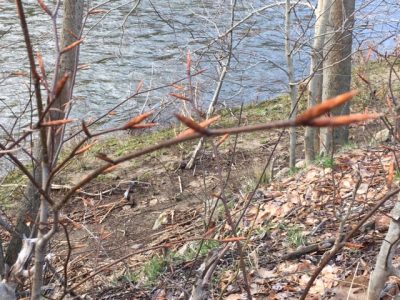Just Another Spring in Progress?

My corner of New York’s Catskill Mountains is shortly due to explode in green. Today however, it’s brown, beige, russet and auburn: a wrapping of spindly trunks with naked branches cascading uphill draws my eyes to the horizon. I wait. My neighbors wait. Landscapers and gardeners wait. We wait to plant even a few pansies; we wait before replacing our glass doors with screening. Big Tim waits before detaching his truck plow so we too keep our snow shovels handy.
Impatiently, in search of soft loam, I strike into a plot in front of the house. Not far beneath dry white grass and pallid corn stubble, the steel of the spade meets resistance—not rock but still frozen earth not far below the surface.
Other warnings of change are undeniable however. First there’s the smell of the air itself – not fragrant yet still inviting; new sounds floating through the atmosphere invite me to ease open a window early in the morning.
Male merganser ducks arrive and stake out their territory along the riverbank. Small creatures lodged under bark or found other moist crevices during their metamorphosing months stir. I slap at two insects as they fly past me eager to flee the stale winter air of the house. Though they’ll soon encounter predators gathered in nearby branches.
With snow and ice finally gone, we really don’t want more precipitation, even if it’s spring rain. Sun is enough, we feel. But it’s not up to us, is it? We should not forget how millions of living things evolved to this point, their descendants surviving this winter, to awaken only if saturated by tomorrows’ downpours. Indeed, rains are forecast to arrive on schedule. They’ll soften the dark loam and soak into it to loosen that ice underground.
In the cities, rain may be welcomed to wash off their smelly, gritty streets. Here, while it may nourish the soil, rain creates acres and miles of mud: heavy slosh that spatters cars, ruts driveways, sticks to shoes and reaches across hallway floors.
A few days ago when I ventured northward deeper into Delaware County, I was surprised—somewhat envious too – to survey fields of bright green grass already sprouting across treeless meadows and still unplowed garden farms. Covetousness gives way to the reassurance of winter’s end. Our valley on the south side of the watershed will soon have its turn.
On this drive through the hills my very first recognition of spring is not in green but in red; hillsides covered by naked trees are tinged in burgundy. Hmmm, these are not fruit trees but green-leaf trees, I remark to my companion. Then I’m reminded how those red buds are just protective sleeves; soon all will give way to tender green pushing from within.
Be patient. Nothing is definitive at this point; but it’s there, inside that burgundy mist. In days, if not hours, the green will strike out. If we miss the burgundy signal of spring we may detect it in a new morning light. I fantasize that this change of light is actually the rising energy of photosynthesis, of green creeping out of those billions of buds high on the hillside, across the meadows, lining the riverbank, through a sparse orchard, around corn-stubbled fields.
It doesn’t matter if we fail to notice the shift from burgundy to tender green. That green will thoroughly capture us and hold us for many months.
In Iraq, spring, always brief, has lingered this year because of good rains. “Merciful rain” is how Iraqis greet whatever precipitation blesses their land. This, after two hard and worrisome years of drought. My friend in Kerbala reports that his garden remains in bloom today, long past what he’d expected. Iraq’s northern wheat fields are high and dense too, thanks to heavy winter rains; we’ll have a normal harvest before summer’s pitiless heat descends. Across the border, after a long and painful arid period, Syria’s northern wheat basket is once more readying to feed its parched and forlorn inhabitants. Colleagues in both nations talk with pleasure and gratitude of extended and abundant rains this winter.
It’s hard not to be mollified by the return of spring here, and by good rains across the Levant. How could these cycles possibly be so distorted by massive global shifts threatening our entire planet? Well, they can. And the sight of the changeover of seasons can impress on us just how vulnerable everything is. Trained people are systematically measuring water temperatures on which so many creatures and plants depend. How populations are decreasing and shifting and how habitations are disrupted at alarming rates are unarguable.
Better accept spring not as a familiar visitor but as a newborn in need of very special care. Take nothing for granted—neither spring’s green nor political liberties.
*
Note to readers: please click the share buttons above. Forward this article to your email lists. Crosspost on your blog site, internet forums. etc.
Barbara Nimri Aziz is a New York based anthropologist and journalist. She is the author of “Tibetan Frontier Families” and numerous articles on Tibet and Nepal, has been working in Nepal in recent weeks. Find her work at www.RadioTahrir.org. She was a longtime producer at Pacifica-WBAI Radio in NY.
Featured image is from the author

